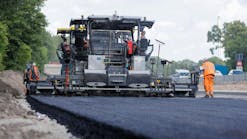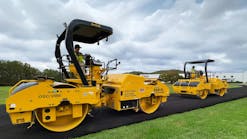Warm-Mix Asphalt (WMA) Potentially Can Provide Important Benefits for Paving Contractors, Reduce Fuel Costs and Diminish Green-House Gases
Not too long ago, some smart people in the asphalt-paving industry got to thinking about the potential benefits of reducing the temperature at which asphalt mixes are produced and placed. Instead of conventional hot-mix, which typically is loaded into trucks at the plant in the temperature range of 280F to 325F, why not a "warm-mix" that could be produced at temperatures in the range of 180F to 260F?
What might be the potential benefits of dropping the temperature? Chief among them, perhaps, would be the reduction of fuel burned in the production process, translating into lower energy costs, of course, but also translating into a reduced volume of "green-house gases" from the plant's stack.
Some scientists believe that an excess of greenhouse gases from man-made sources (mainly carbon dioxide from burning fossil fuels) may be collecting in the Earth's atmosphere, upsetting the natural balance of gasses that regulate the amount of heat (infrared radiation) that escapes from the Earth through the atmosphere. Trapping too much heat, some say, contributes to the suspected phenomenon of global warming.
During the past 30 years or so, pollution-control devices have significantly reduced emissions from asphalt plants. But, that said, air-quality regulators still perceive the creation of greenhouse gasses from fossil-fuel combustion (no matter the source or its degree of contribution) as a significant environmental problem. Understandable, then, is the asphalt industry's concern about inefficient fuel use.
For example, says David Newcomb, P.E., Ph.D., vice president of research and technology for the National Asphalt Pavement Association (NAPA), mixes made with polymer-modified binders are considered by some as more difficult to work than mixes with unmodified asphalts. In an effort to improve workability of these mixes, he says, the producer may raise production temperatures. Elevating temperatures also may be considered, says Newcomb, for easing production of mixes containing aggregates of greater angularity (requiring increased mixing force), or for creating compaction-friendly mixes that must meet high-density specifications.
"Increasing production temperature to address these concerns seems expedient, but often is not effective," says Newcomb. "For little or no improvement in workability, increasing mix temperature results in increased plant emissions and fumes at the paving site."
While the concept of warm-mix asphalt (WMA) goes to the heart of potentially mitigating emissions and fuel-use concerns, it also offers the prospect of greater flexibility when transporting, placing and compacting the mix.
"When a mix is produced at a lower temperature, the rate at which it loses heat is lower, which means there may be a longer period of time that it remains workable," says Newcomb. "Haul distances and time for compaction may be increased."
In addition to potentially longer haul distances, the ability to pave and compact asphalt mixes at cooler temperatures could, further, allow an extended paving season. And, with regard to compaction, not only might the compaction-time window be opened a bit wider, but greater in-place densities also may result, because WMA is demonstrating an ability to compact more easily than conventional hot mixes.
Newcomb notes, too, that the asphalt binder's aging is directly related to production temperature, and if temperature is reduced, so is the oxidative hardening of the binder. Going easier on the binder when producing the mix, he says, could mean more pavement flexibility and improved resistance to cracking.
At the paving site, of course, placing the mix at a lower temperature could significantly reduce fumes, complementing fume-extraction systems already fitted on pavers. And, relatively speaking, the work site would be cooler. In a European field trial of a particular WMA formulation, for example, paving temperature was 194F, compared with a conventional-hot-mix control section placed at 320F.
Considering the potential benefits derived from lowering the production and placement temperatures of asphalt mixes, it's understandable that the asphalt-paving community is devoting considerable resources to determine if the WMA concept can deliver on its promises. WMA has been used on a number of demonstration projects here at home, and on a few significant projects elsewhere in the world. Results have been promising, but caution prevails, lest we step backward in regard to present pavement quality.
WMA mechanics and methods
In the broadest of terms, the production of WMA depends on creating a binder with lowered viscosity — or modifying the binder to make it work as if its viscosity were lowered. Binders with these properties are able to coat aggregate effectively at reduced temperatures, and these properties are controlled by using a proprietary additive in the binder or as a mix ingredient, by employing a proprietary process that results in foaming the binder — or by using both methods, as does the Low Energy Asphalt (LEA) concept.
At present, three proprietary additives for producing WMA are marketed in the United States: Sasobit, Aspha-min, and Evotherm. The proprietary processes are LEA and WAM-Foam (WAM for Warm Asphalt Mix).
To give you a quick overview of the proprietary additives, Sasobit is a product of Sasol, an international company with a North American operation — Sasol Wax Americas — in Shelton, Conn. According to Matthew Corrigan, with the Federal Highway Administration's Office of Pavement Technology, Sasol describes its product as an "asphalt flow improver."
Sasobit, says Corrigan, is a synthetic wax produced from coal gasification, a process that treats white-hot hard coal or coke with steam to produce a gas, which is then exposed to catalysts to create such liquid products as synthetic gasoline and the paraffin wax used in Sasobit. According to Sasol, Sasobit melts at about 210F and "significantly reduces the viscosity of the base bitumen."
The proprietary product, Aspha-min, a granular additive combined into the mix, was developed by Eurovia and the MHI Group (the consolidated subsidiaries of Mitsubishi Heavy Industries). The product is a synthetic "zeolite," a crystal-like material with a "micro-porous" structure (many connected chambers) that can hold as much as 20 percent of the crystal's weight in water.
When Aspha-min is added to the mix and exposed to the heat of the injected binder, says the manufacturer, the water in the granules is "liberated in the form of a finely dispersed water vapor," causing the binder to foam, increasing its volume, and "keeping the asphalt mixture supple and workable even at low temperatures."
Evotherm, a product manufactured by Asphalt Innovations (a MeadWestvaco business in Charleston, S.C.), is a chemical package added to an emulsified binder. According to the company's business development manager, Jonathan MacIver, Evotherm uses a variety of chemistries to target five critical performance properties — mixing, coating, workability, compaction and adhesion.
The emulsion, says MacIver, is an effective means of homogeneously delivering the chemistry, which is present not only in the water, but also imbedded in each asphalt droplet.
Surfactants in the Evotherm package, for example, are designed to modify surface tension at the interface of the asphalt binder and the aggregate, promoting effective coating at a lower temperature. And the same chemistry that helps asphalt stick to rock, says MacIver, also helps it adhere to rock in the presence of moisture. In addition, the Evotherm chemistry also contributes to the binder's lubricity, he says, facilitating workability and compaction.
(According to MacIver, a modified Evotherm package used in testing at the National Center for Asphalt Technology resulted in a mix with a TSR — tensile strength ratio — higher than 100 percent. This indicates, he says, that the mix actually had a higher strength when wet than when dry.)
Among the process methods for producing WMA is the LEA approach, which was developed by the French company Fairco. We're assuming that LEA is a proprietary process, since Fairco filed for French, European and international patents in 2003, and because the process does employ a proprietary binder additive. We're also assuming proprietary status for the WAM-Foam process, which is not yet marketed in the United States, but might be soon.
In the LEA process, only the coarse aggregate is dried (reaching a temperature of around 300F), and it is then mixed with hot binder, which has been treated with Fairco additives. When mixing is complete, the smaller aggregate and sand are added at ambient temperature and without being dried.
The moisture contained in the small aggregate, says Fairco, initiates a complex reaction that results in binder foaming and expansion, encapsulation of small aggregate particles by the foamed binder, heating of the small aggregate and "recondensation of excess water, which is uniformly distributed in the mix." This reaction is enhanced by means of the additives in the binder, says Fairco, and results in producing mixes at temperatures lower than 100C (212F). Subsequently placing these mixes, according to the company, can be accomplished at temperatures from 140F to 195F.
The WAM-Foam process is a joint venture between Shell International Petroleum and Koko Veidekke, Norway's largest asphalt-mix producer. According to the FHWA's Corrigan, two separate binder components are used in the WAM-Foam process, a "soft" and a "hard." The lower-viscosity soft binder is mixed first with the aggregate at a temperature of approximately 230F.
Then, as the heated hard binder is being added, it is injected with steam, causing it to foam as it mixes with the pre-coated aggregate. According to Corrigan, Shell states that the WAM-Foam process depends on careful selection of the hard and soft binders, and that in some instances, the company recommends the addition of an adhesion improver in the first mixing stage.
Investigating performance
Brian Prowell, assistant director for the National Center for Asphalt Technology (NCAT), and NCAT research engineer, Graham Hurley, conducted evaluations of Aspha-min, Sasobit and Evotherm. Their procedures and conclusions are published in NCAT reports 05-04, 05-06 and 06-02, respectively. NCAT worked with NAPA, FHWA and manufacturers of the WMA additives during the evaluations.
According to Prowell and Hurley, the objective of the study was "to determine the applicability of these processes to typical paving operations and environmental conditions commonly found in the United States, including the performance of the mixes in quick-traffic-turn-over situations and high-temperature conditions."
According to the researchers, the use of these three products provided a generally positive affect on the mix. In a summary statement, they note that mixes produced with the additives exhibited an overall reduction in air voids and in improved compaction, and that Superpave-gyratory-compactor results indicated that using these products may lower the optimum asphalt content of the mix.
Using the products, say Prowell and Hurley, also did not affect the resilient modulus of the mix. Nor did these additives increase rutting potential (as measured by the Asphalt Pavement Analyzer — a laboratory tester that assesses, among other factors, a pavement's permanent deformation). Rutting potential did increase with decreasing mixing and compacting temperatures, say the reports, "which may be related to the decreased aging of the binder." Testing also indicated that traffic-turnover time for WMA was about the same for conventional hot mixes.
One concern the researchers did raise, however, was that of potential for moisture damage. According to the reports, this potential downside of WMA could result from lower mixing temperatures not completely drying the aggregate, causing water to be trapped in the coated stone. Experimentation with various anti-stripping agents, however, seemed to mitigate the problem.
At present, says Prowell, NCAT is studying field-test sections around the country, including Evotherm sections placed at the NCAT Test Track. So far, he says, performance has been good, and rutting and moisture damage have not been problems to date.
WMA outlook
Even though the initial work by Prowell and Hurley indicate that Aspha-min, Sasobit and Evotherm "appear as viable tools for reducing mix and compaction temperatures," the asphalt-paving industry is moving cautiously as it learns more about WMA — its processes and its real-world performance.
Unanswered at this point, for example, are questions about the economics involved. Will potential fuel savings, for instance, justify the possibly higher cost of WMA — for additives or for plant modifications that might be required? We asked FHWA's Corrigan to sum up what he sees as the future for WMA:
"A powerful driver for the industry to develop warm-mix-asphalt technology is the concern for emissions. But we want to make sure that this concern — as well as the prospect of other benefits — is balanced with a concern for quality materials and best practices. Pavements have to last, and we don't want to backslide on today's pavement quality when accommodating new technology."
We asked NAPA's Newcomb the same question:
"Warm-mix asphalt is a tool in the tool box, but it's not yet ready for prime-time. The technology will prove very useful if environmental regulations become tighter in defining limits for greenhouse gases. In ozone-non-attainment areas, for example, warm mix may be a way for plants to operate longer on a daily basis. Warm mix also could allow contractors to extend their paving season, or to haul greater distances from plants.
"Although reducing temperature offers a way of reducing energy consumption, the technologies do not currently save enough on these costs to justify the added expense of warm mix. Greater energy savings may be realized when aggregate used in the warm mix is in as dry a state as possible before introduction into the plant."
If you're an asphalt-paving contractor or a mix producer, stay tuned.




